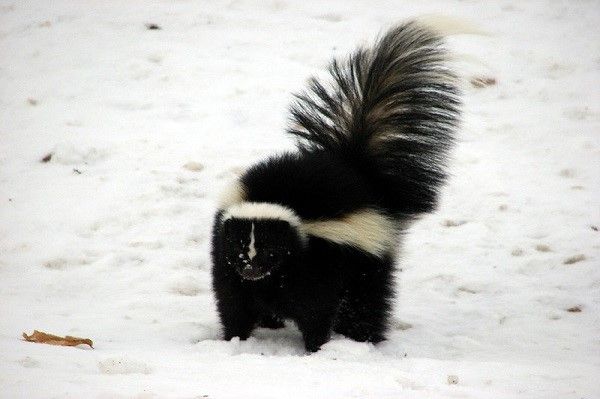
Skunks are small, black-and-white animals known for their ability to spray a foul-smelling liquid when they feel threatened. They have white stripes running down to their backs and on their flanks.
This creature belongs to the family of mammals Mustelidae, which includes weasels, otters, and badgers. There are more than 60 species of skunks, divided into two groups: Old World skunks and New World skunks. While they exist as different families, they possess similar characteristics. So, what do they actually look like?
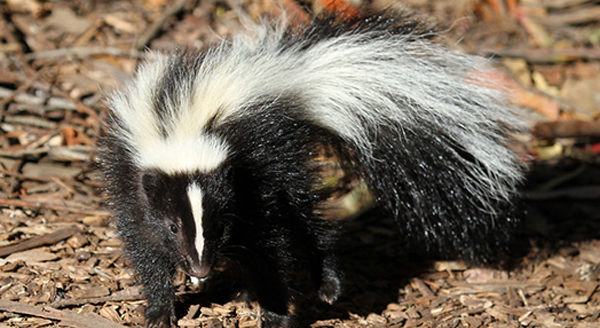
Skunks Appearance
Skunks have characteristics that make them easy to identify. They typically have black fur with white stripes running down their backs. These stripes can also be present on the sides of their bodies, but they always run from the top of the skunk’s head all the way down its back.
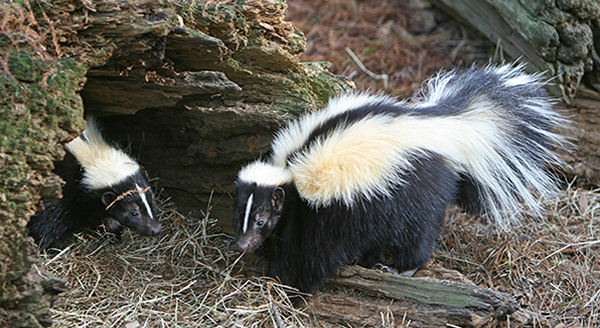
Size and shape
Skunks have small heads with pointed snouts. Their eyes are relatively small, beady, and set far apart. They also have long claws, short legs, and long, thick, and bushy tails.
Skunks can be as large as a domestic cat or as small as a chipmunk. The largest skunk is the hog-nosed skunk, which can grow up to 3 feet long and weigh up to 20 pounds. The smallest skunk is the pygmy skunk, which only grows to be about 6 inches long and weighs less than 1 pound.
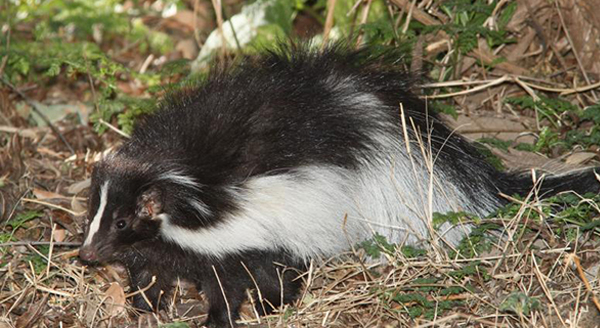
Color
Skunks are usually black with white stripes running down their backs. However, some skunks can be brown, gray, or even cream-colored.
The most common type of skunk is the striped skunk, with alternating black and white stripes running down its back. The least common type of skunk is the albino skunk, which is white with pink eyes.
Skunks also have two types of fur: long guard hairs and short, dense underfur. The guard hairs are stiff and coarse, while the underfur is soft and thick. This combination of fur keeps skunks warm in the winter and cool in the summer.
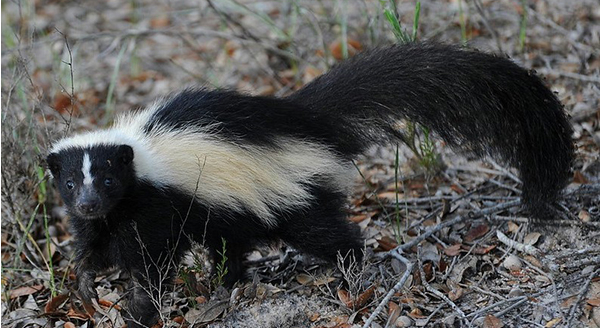
Tail
Skunks have long, thick, and bushy tails. Their tails can be as long as their bodies or even longer. Skunks use their tails to communicate with other skunks. They also use them to balance when they are walking or running. The striped skunk has the longest tail, while the hog-nosed skunk has the shortest tail.
Behavior
Skunks are nocturnal animals, which means they are most active at night. During the day, they sleep in dens or burrows that they have dug themselves.
Skunks are also solitary animals, which means they live alone. They don’t stay in groups or forage for food in groups. The only time they come together is when they mate. But, after mating, the male and female skunks immediately separate, cutting off any form of connection.
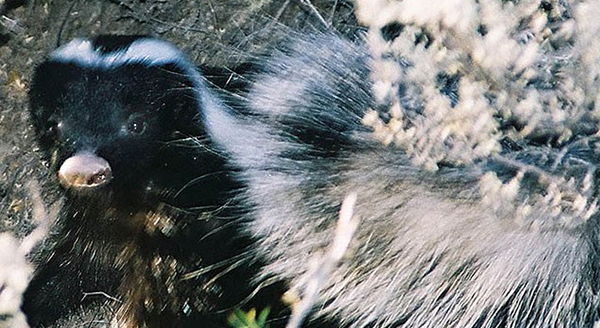
Skunk Spray
Skunks are best known for their ability to spray a foul-smelling liquid when they feel threatened. This liquid is called skunk spray, and it is produced by two glands located near the skunk’s anus.
These are two small, nipple-like glands between the anus and genitalia. These glands can produce a very potent and foul-smelling liquid that skunks use for self-defense and territorial marking. The glands are filled with a mixture of sulfur-containing compounds, including thiols.
When the skunk feels threatened, it contracts the muscles around its anus and squeezes the thiol-containing liquid out of the glands and into the air. Getting sprayed in the eyes with this foul chemical concoction can cause temporary blindness.

Baby Skunk
Skunks can give birth to 4-6 babies during their mating season. They are born altricial which means they’re blind, undeveloped, naked, and deaf. This is contrary to precocial babies, born well-developed, with eyes open, covered in fur, and able to walk.
These baby skunks look like their parents, only much smaller. They have the same black fur with white stripes running down their backs. But, they don’t have the ability to spray yet. That doesn’t develop until they are about 6-8 weeks old.
Baby skunks are called kits. A kit’s stripes are not fully developed and won’t be until it reaches adulthood.
Mother skunks will stay with the young skunks until they are old enough to fend for themselves, usually around six months. The babies will then start going out by themselves to forage for food. But, they will continue to live with their mothers until they are ready to mate and have their own
The different kinds of skunks
You may stumble on various skunk species. They can be of different sizes, colorations, and behavior. Here are the most common species you may encounter:
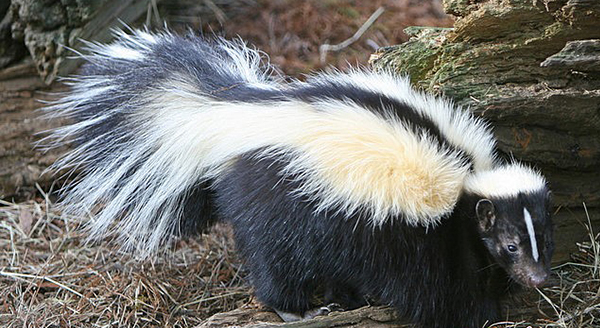
Striped skunk
The striped skunk (Mephitis mephitis) is North America’s most widespread skunk species. It only has two thick white stripes that run from the back of the head and up to the beginning of the tail. This appears as an inverted V, and their tails are a mix of both black and white fur.
The striped skunk is commonly found in suburban areas. They grow 18 to 32 inches long and weigh between 1.5 and 13 pounds.
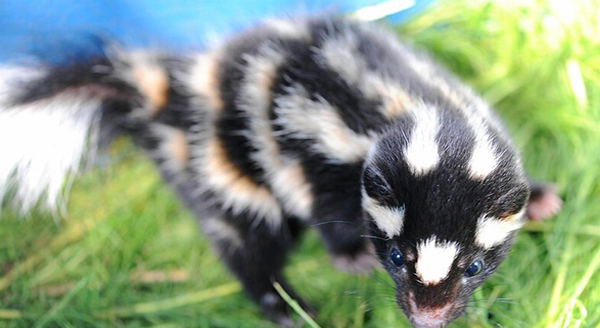
Spotted-skunk
The spotted skunk (Spilogale putorius) is the second most common skunk in North America. They are also called the civet cat, zorille, and civet skunk. Unlike the striped skunk, spotted skunks have more white stripes, which more likely appear as elongated spots that run from their forehead down to their backs.
These species appear to be much slender than the familiar skunk. They are classified into two varieties: the western spotted skunk and the eastern spotted skunk.
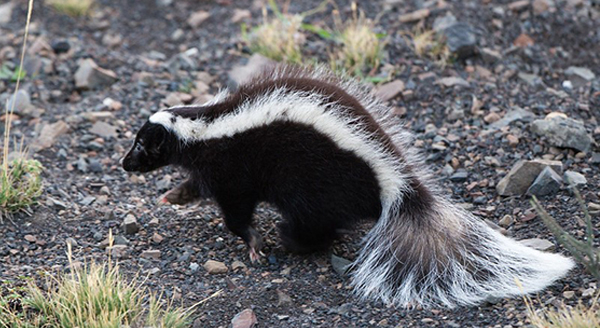
Hog-nosed skunk
Hog-nosed skunks (Conepatus) are very large skunks that only have a single broad white stripe that starts from their forehead and extends to the end of their tail. They are also called sand skunks, wood skunks, and rooter skunks.
This species is larger than most skunks. Their average length is about 32 inches long (with a tail length of 10 inches). They also weigh about 10 pounds or more.
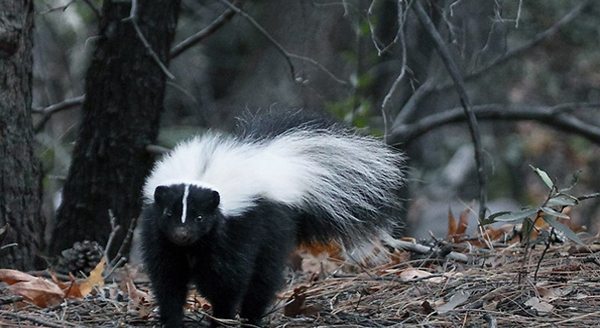
Hooded skunk
Their name is derived from their prominent ruff or “hood” of long hair that encircles their neck. Their backs are black with a single white stripe that runs down the center.
Hooded skunks (Mephitis macroura) may sometimes be confused with striped skunks, but their long tails and softer fur easily distinguish themselves from the striped ones.
But, how did their identities become confused with the striped skunks? This is because some hooded skunks may either have a single or a double white lining from forehead to back.
Other Skunk Species
There are many other skunks that exist in the wild. This includes the Striped hog-nosed skunk, American hog-nosed skunk, Humboldt’s hog-nosed skunk, and the Pygmy spotted skunk.
These species have various unique physical characteristics that make them different from other skunk species. But, they all have one thing in common—they can all spray a foul-smelling liquid to ward off predators or other threats.
What Do Skunk Droppings Look Like?
Skunk droppings look like those of domestic dogs. They are usually 2 to 3 inches in length with a diameter of about ½ an inch. The ends are generally blunt, round, or tubular.
Skunk droppings may contain undigested seeds, berries, insects, and hair. You will also see shiny bits of insect exoskeleton in their poop. This is because skunks are carnivores, and their diet consists primarily of invertebrates.
The foul smell of skunk droppings can be overwhelming, especially if you have many in your yard. If this happens, your best action is to contact a professional for assistance.
What does a skunk burrow look like?
Skunks dig small, round holes about 4 to 6 inches wide. The holes are usually shallow, only a few inches deep. Skunks will also dig under rocks, logs, and bushes for food.
The most common place you’ll find a skunk’s dig is in your garden or flower beds. Skunks are attracted to the smell of food, so they will dig in areas where they think there is a good chance of finding something to eat.
Skunk tracks and skunk dens differ from gophers, raccoons, and moles because they do not have the telltale cone of dirt left behind when those animals excavate their tunnels.
Problems and Dangers Caused By Skunks
Although skunks are generally harmless animals, they can pose a danger to humans and pets when they feel cornered. Skunks will usually only spray their musk if they are frightened or threatened, but it is still essential to be careful around them.
Property damage is one of the problems commonly encountered by homeowners. Skunks will dig holes in lawns and gardens in search of grubs and other insects to eat. The holes can be a trip hazard and make your yard look unsightly.
Skunks can also carry rabies, a severe disease that can be fatal to humans and animals. Other conditions that are possibly transmitted include leptospirosis, distemper, and hepatitis.
What are the signs of skunk damage?
As previously noted, skunks can cause several problems and dangers. When this happens, they leave traces that best point themselves as culprits. Some of the signs are as follows:
- Holes in your lawn or garden
- Gnawing marks on wooden structures
- Foul odor coming from a particular area
- Sightings of skunks during the day
If you see any of the following signs, it is best to call a professional immediately.
Need Help With Skunks Infestation? Call Us Now!
A skunk infestation can cause enough property damage to disrupt your peaceful home. They create holes in your lawn and leave gnawing marks on your property. Not just that, but they bring with them several diseases and life-threatening infections. If they appear on your property frequently, it’s best to call AAAC Wildlife Removal.
We at AAAC Wildlife Removal will take care of the problem quickly and efficiently. We have the experience and knowledge to get rid of skunks without causing any further damage.
We handle pests in buildings, homes, or business establishments of all types and sizes. We also have a 24/7 emergency service to take care of your skunk problem as soon as possible. So call us now, and let us help you get rid of your skunk problems!
Final Word
All skunks have prominent white stripes running down the center of their backs. The width and number of these stripes can differ from species to species. Striped skunks have two thick stripes, while the spotted skunk has several thinner lines on its sides.
Hog-nosed skunks exist too. They have a broad white strip that runs from the forehead down to the back. And we also have hooded skunks with distinct white fur encircling the neck.
While these animals are inhabitants of the wild woods, some of them inhabit suburban areas. So, you are more likely to encounter them even when walking down the streets. This increases the likelihood of them making your area their habitat. When they do, they can bring various damage and health risks.
FAQs
What do skunks eat?
Skunks eat insects, grubs, rodents, and small animals. Skunks are omnivores, so they eat many fruits and plants besides animal matter.
What predators do skunks have?
The predator of skunks includes bobcats, coyotes, foxes, and owls.







